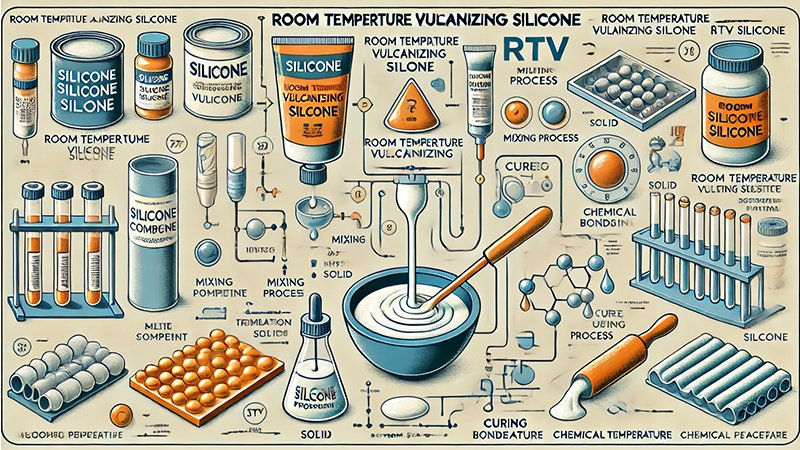실온 경화(RTV) 실리콘은 다양한 산업 분야에서 널리 사용되는 다용도 소재입니다. 사용하기 쉽고 성능이 뛰어난 것으로 알려진 RTV 실리콘은 내구성과 유연성이 요구되는 응용 분야에 이상적입니다.
RTV 실리콘은 실온에서 경화되는 실리콘 유형으로, 열이 필요하지 않습니다. 이 경화 과정은 공기 중의 수분이나 두 구성 요소 간의 화학 반응을 통해 시작됩니다. RTV 실리콘은 접착력, 유연성, 극한 온도에 대한 저항성이 뛰어나 실런트, 접착제, 금형에 적합합니다. 열 없이 경화할 수 있는 능력 덕분에 많은 응용 분야에서 편리하고 효율적인 솔루션이 됩니다.
RTV 실리콘의 장점과 용도를 알면 정보에 입각한 결정을 내리는 데 도움이 될 수 있습니다. 그 특성, 용도 및 이점을 자세히 살펴보겠습니다.
실온 가황 실리콘은 어떻게 작동합니까?
RTV 실리콘은 상온에서 화학 반응을 통해 경화됩니다. RTV 실리콘에는 1성분(1K) 시스템과 2성분(2K) 시스템의 두 가지 주요 유형이 있습니다.
1액형 RTV 실리콘
- 수분 경화: 1액형 RTV실리콘은 공기중의 수분에 노출되면 경화됩니다. 이는 가열이 불가능한 응용 분야에 편리합니다.
- 쉬운 신청: 바로 사용할 수 있어 빠른 수리 및 씰링 작업에 적합합니다.
2액형 RTV 실리콘
- 화학 반응: 2성분 RTV 실리콘은 혼합이 필요합니다 두 부분, 일반적으로 염기와 경화제. 그런 다음 혼합물은 실온에서 경화됩니다.
- 제어된 경화: 이 유형은 경화 과정을 더 잘 제어할 수 있으며 더 크거나 복잡한 응용 분야에 적합합니다.
RTV 실리콘을 사용하면 어떤 이점이 있나요?
RTV 실리콘은 다른 유형의 접착제 및 실런트에 비해 많은 장점을 제공합니다. 이러한 이점으로 인해 다양한 산업 분야에서 선호되는 선택이 되었습니다.
- 사용의 용이성: 열이나 특별한 장비가 필요없이 상온에서 경화됩니다.
- 다재: 밀봉, 접착, 성형 등 폭넓은 용도에 적합합니다.
- 내구성: 극한의 온도, 화학물질, 자외선에 강해 오랫동안 지속되는 성능을 보장합니다.
- 유연성: 경화 후에도 유연성을 유지하며, 이는 움직임이나 진동이 있는 용도에 매우 중요합니다.
RTV 실리콘의 응용 분야는 무엇입니까?
RTV 실리콘은 다양한 특성으로 인해 광범위한 응용 분야에 사용됩니다. 이러한 애플리케이션은 다양한 산업 분야에 걸쳐 적용되며 적응성과 신뢰성이 강조됩니다.
자동차 산업
- 개스킷 및 씰: RTV 실리콘은 고온과 가혹한 환경을 견뎌야 하는 가스켓과 씰 제작에 사용됩니다.
- 접착 및 밀봉: 자동차 조립 부품의 접착 및 밀봉에 적합합니다.
건설 및 건축
- 실런트: 건물의 이음매 및 틈새 밀봉용으로 사용되며 내후성이 우수합니다.
- 접착제: 건축 프로젝트에서 유리, 금속, 플라스틱 등의 재료 접착에 적합합니다.
전자제품
- 캡슐화: 전자부품을 습기와 오염물질로부터 보호하기 위해 전자부품을 밀봉하는데 사용되는 RTV 실리콘입니다.
- 단열재: 유전특성으로 전자부품에 절연성을 부여합니다.
소비재
- 금형제작: 수지, 왁스, 기타 재료의 주조용 금형 제작에 적합합니다.
- 주방용품: 무독성이므로 제빵용품, 주방용품 제조에 사용됩니다.

RTV 실리콘을 올바르게 적용하는 방법은 무엇입니까?
최적의 결과를 얻으려면 RTV 실리콘을 올바르게 적용하는 것이 중요합니다. 모범 사례를 따르면 강력한 결합과 효과적인 밀봉을 보장할 수 있습니다.
신청 단계
- 표면 준비: 접착 또는 밀봉할 표면을 깨끗이 세척하고 건조시킵니다. 먼지, 기름 또는 오염 물질을 제거하십시오.
- 실리콘 도포: 1액형 RTV의 경우 튜브나 카트리지에서 직접 도포합니다. 2개 구성 요소로 구성된 RTV의 경우 제조업체의 지침에 따라 구성 요소를 혼합합니다.
- 실리콘 다듬기: 경화가 시작되기 전에 주걱이나 손가락을 이용해 실리콘을 부드럽게 펴주세요. 깔끔한 마무리를 위해 비눗물을 사용하여 달라붙는 현상을 방지하세요.
- 경화시간: 실리콘이 완전히 경화되도록 놔두세요. 1성분 RTV는 일반적으로 24시간 내에 경화되는 반면, 2성분 RTV는 제형에 따라 달라질 수 있습니다.
RTV 실리콘의 일반적인 과제는 무엇입니까?
RTV 실리콘은 많은 이점을 제공하지만 특정 과제도 제시합니다. 이러한 과제를 이해하면 문제를 완화하고 성공적인 적용을 보장하는 데 도움이 될 수 있습니다.
- 경화시간: 경화 시간은 온도와 습도에 따라 달라질 수 있으며, 이로 인해 경화 속도가 느려질 수 있습니다.
- 접착 문제: 접착 문제를 예방하기 위해서는 적절한 표면 처리가 필수적입니다.
- 보관 및 취급: RTV실리콘은 올바른 보관이 필수입니다. 습기에 노출되면 조기에 경화가 시작될 수 있습니다.
RTV 실리콘은 다른 재료와 어떻게 비교됩니까?
RTV 실리콘은 아크릴, 폴리우레탄, 에폭시와 같은 다른 소재에 비해 뚜렷한 장점을 제공합니다. 이러한 자료를 비교하면 특정 요구 사항에 가장 적합한 옵션을 선택하는 데 도움이 될 수 있습니다.
아크릴과의 비교
- 유연성: RTV실리콘은 시간이 지나면 부서지기 쉬운 아크릴보다 유연성을 더 잘 유지합니다.
- 내구성: RTV 실리콘은 더 자외선에 강함 극한의 기온.
폴리우레탄과의 비교
- 화학적 내성: RTV 실리콘은 폴리우레탄에 비해 내화학성이 우수합니다.
- 온도 공차: RTV 실리콘은 더 높은 온도에서도 분해되지 않고 견딜 수 있습니다.
에폭시와의 비교
- 사용의 용이성: RTV 실리콘은 상온에서 도포 및 경화가 용이한 반면, 에폭시는 정밀한 혼합과 높은 경화 온도가 필요한 경우가 많습니다.
- 탄력: RTV 실리콘은 경화 후에도 유연성을 유지하는 반면, 에폭시는 더 단단할 수 있습니다.
RTV 실리콘의 미래 동향은 무엇입니까?
기술이 발전함에 따라 RTV 실리콘의 새로운 제형과 응용 분야가 계속해서 등장하고 있습니다. 이러한 혁신은 성능을 향상하고 다양한 분야로의 사용을 확대하는 것을 목표로 합니다.
새로운 트렌드
- 친환경 제제: 지속가능한 성분과 공정을 활용하여 환경에 미치는 영향을 최소화한 RTV 실리콘 제품 개발.
- 향상된 속성: 접착력, 경화 시간, 극한 조건에 대한 저항성을 향상시키는 혁신적인 제형입니다.
- 고급 애플리케이션: 항공우주, 신재생에너지, 첨단제조업 등 첨단산업에서의 활용도가 높아졌습니다.
결론
상온 경화 실리콘은 다양한 산업 전반에 걸쳐 수많은 응용 분야를 갖춘 다재다능하고 신뢰할 수 있는 소재입니다. 사용 용이성, 내구성 및 유연성으로 인해 실란트, 접착제 및 금형에 탁월한 선택이 됩니다. 몇 가지 어려움에도 불구하고 적절한 적용 기술과 모범 사례 준수는 성공적인 결과를 보장합니다. 기술이 발전함에 따라 RTV 실리콘의 새로운 트렌드는 계속해서 기능을 향상하고 응용 분야를 확대할 것입니다.
관련 기사: